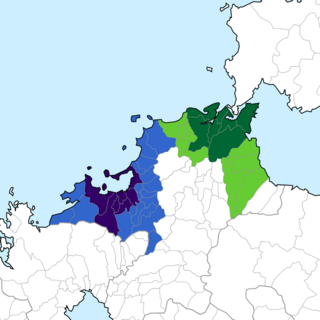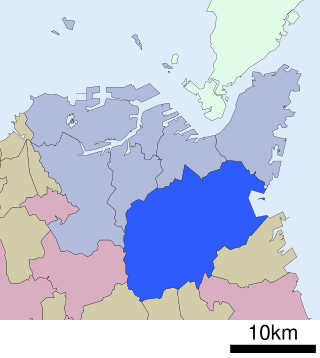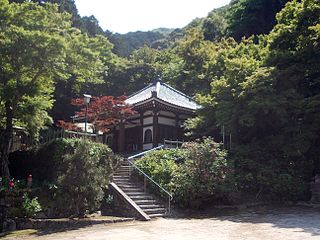
Ōkawa is a city located in Fukuoka Prefecture, Japan. The city was founded on April 1, 1954.

Maebaru was a city located in Fukuoka Prefecture, Japan. It existed from October 1, 1992, to December 31, 2009.

Hakata Station is a major railway station in Hakata-ku, Fukuoka, Japan. It is the largest and busiest railway terminal in Kyushu, and is a gateway to other cities in Kyushu for travelers coming from Honshu by rail travel. The San'yō Shinkansen from Osaka ends at this station.

Nakagawa is a city located in Fukuoka Prefecture, Japan. The city was founded on October 1, 2018, making it the newest city in Japan.

Nijō was a town located in Itoshima District, Fukuoka Prefecture, Japan.

Shima was a town located in Itoshima District, Fukuoka Prefecture, Japan.

Fukuoka-Kitakyushu Greater Metropolitan Region is the most common name given to the region comprising the metropolitan areas of the cities of Fukuoka and Kitakyushu in Fukuoka Prefecture, Japan and in between. Alternate names are many, including Kitakyushu-Fukuoka Greater Metropolitan Region (北九州・福岡大都市圏), Northern Part of Kyushu Greater Metropolitan Region (北部九州大都市圏)

Kokuraminami-ku (小倉南区) is a ward of Kitakyūshū, Fukuoka, Japan. It is the southern part of what used to be Kokura City, which was merged into Kitakyūshū city when the latter was created out of the merger of five cities in 1963. At this time Kokura was divided into North and South wards.
Nakasu (中洲) is the red-light district which exists between the sandbank of the Naka River and the Hakata River in Fukuoka City, Fukuoka Prefecture, Japan. It is named after a popular, but very short-lived, entertainment quarter of Edo, which existed in the late 18th century. The name "Nakasu" can be translated as "the island in the middle", as Nakasu is an island between two rivers.
Fukuoka Convention Center in Hakata-ku, Fukuoka, Japan is a collection of three separate buildings operated by the Fukuoka Convention Center Foundation.

Tenjin-Minami Station is a subway station located in Chūō-ku, Fukuoka. It is connected to Tenjin Station and Nishitetsu Fukuoka (Tenjin) Station through the Tenjin Chikagai, an underground shopping street. The station symbol is children playing the "Tōryanse" game.

Fukuoka Airport Station is a Fukuoka City Subway station serving Fukuoka Airport in Fukuoka prefecture, Japan. The station symbol is a blue airplane and a cloud. This is the only subway station in Japan which directly connects with an airport.

Najima Castle is a hilltop castle, located in Fukuoka City, Fukuoka Prefecture, Japan. Today, only its ruins still stand.

Fukuoka Art Museum is an art museum in Fukuoka, Japan. It contains a notable collection of Asian art and exhibits various temporary exhibitions. In November 2010 it hosted a large exhibition of Marc Chagall's work.

Fukuoka Kyuden Kinen Gymnasium is a sports and entertainment facility in Chuo-ku, Fukuoka, Japan. The building was opened by Kyushu Electric Power in 1964, and transferred to the city of Fukuoka in 2003, with the land loaned at no cost. It has a seating capacity of 1,992, with provision for a further 380 standing spectators. In April 2013, Kyushu Electric Power announced that it was planning to sell the site to make up for losses accrued due to the shutdown of its nuclear reactors following the 2011 Tohoku earthquake and tsunami. The building will however remain in use until 2019, by which date a new facility is scheduled to be completed in Higashi-ku, Fukuoka.

Mount Abura is a 597 m (1,959 ft) mountain located on the border of Minami-ku, Fukuoka, Sawara-ku, Fukuoka and Jonan-ku, Fukuoka, Fukuoka Prefecture, Japan. Mount Abura is the location where the Indian Buddhist priest Seiga produced the first camellia oil from seeds made in Japan during the Nara period. Abura means oil in Japanese.

Shōkaku-ji (正覚寺) is a Rinzai temple in Jōnan-ku, Fukuoka, Japan. Its honorary sangō prefix is Higashiaburayama (東油山). It is also known as Aburayama Kannon (油山観音).

Kitakyushu City General Gymnasium is an arena in Kitakyushu, Fukuoka, Japan.

Bairin-ji (梅林寺) is a Rinzai temple in Kurume, Fukuoka Prefecture, Japan. Its honorary sangō prefix is Kōnanzan (江南山). It is known as a representative training dojo temple of the Myōshin-ji school in Kyushu which faces the clear stream of the Chikugo River.

Fukuju-ji (福聚寺) is an Ōbaku Zen temple in Kokurakita-ku, Kitakyūshū, Fukuoka, Japan. Its honorary sangō prefix is Kōjuzan (広寿山). Fukuju-ji is one of two bodaiji (菩提寺), or funeral temples, dedicated to Ogasawara Tadazane, the first daimyō of Kokura Domain.





















